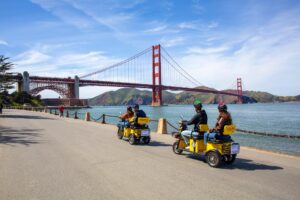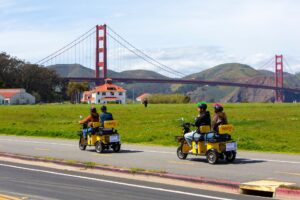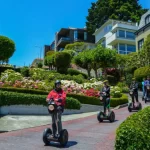Exploring the Dutch Windmill and Queen Wilhelmina Garden in Golden Gate Park
Visiting Golden Gate Park in San Francisco? You’re in for a treat! The Dutch Windmill and Queen Wilhelmina Garden in Golden Gate Park are fascinating attractions with a rich history. Here’s what you need to know:
Dutch Windmill: A Historical Icon
- Location: Northwest corner of Golden Gate Park (near 48th Ave & Fulton)
- Built: 1903
- Architect: Alpheus Bull, Jr. (from the Union Iron Works)
- Cost: $18,160
The Dutch Windmill, also known as the North Windmill, is a testament to San Francisco’s history. It was constructed in 1903 to pump up to 30,000 gallons of well water per hour for park irrigation. This ingenious solution helped transform the once-dry dunes of Golden Gate Park into the lush green oasis we see today.
Restoration Efforts
- 1964: The San Francisco Citizens Commission for the Restoration of the Golden Gate Park Windmills was formed.
- 1981: Thanks to the restoration efforts led by Eleanor Rossi Crabtree, daughter of a former San Francisco mayor, the Dutch Windmill was brought back to life.
The restoration involved rebuilding the tower, adding new cedar shingles, and reassembling the spars. While it no longer pumps water, the windmill stands tall as a picturesque symbol of the park’s history.
Queen Wilhelmina Tulip Garden
- Location: Surrounding the Dutch Windmill
- Blossom Season: March (10,000 tulip bulbs planted each fall)
- Designer: Roy L. Hudson
- Named After: Queen Wilhelmina of the Netherlands (1962)
The Queen Wilhelmina Tulip Garden, adjacent to the Dutch Windmill, is a burst of color and beauty. Every year, thousands of tulip bulbs bloom in March, creating a vibrant display. This garden was named in honor of Queen Wilhelmina, known for her long reign and the symbol of perfect love that tulips represent.
The Windmills’ Historical Significance
The Dutch Windmill, along with its counterpart, the Murphy Windmill, played a vital role in the park’s early development. Here’s a brief overview:
- In the 1870s and 1880s, Golden Gate Park needed substantial irrigation, and the windmills were the solution.
- Both windmills were built between 1902 and 1908.
- By 1913, electric water pumps replaced the windmills, but they remained iconic landmarks.
- Neglect, storms, and the impact of World War II led to their deterioration.
- Thanks to dedicated restoration efforts, the Dutch Windmill was revived in the 1980s.
Plan Your Visit
To experience the charm of the Dutch Windmill and Queen Wilhelmina Garden:
- Location: Head to the northwest corner of Golden Gate Park (near 48th Ave & Fulton).
- Timing: Visit in March to see the tulips in full bloom.
- Enjoy: Take a leisurely stroll, capture photos, and soak in the historical atmosphere.
Don’t miss out on this unique piece of San Francisco’s history and the colorful beauty of the Queen Wilhelmina Tulip Garden. It’s a must-visit for anyone exploring Golden Gate Park.
Information Provided by: San Francisco Rec and Park







